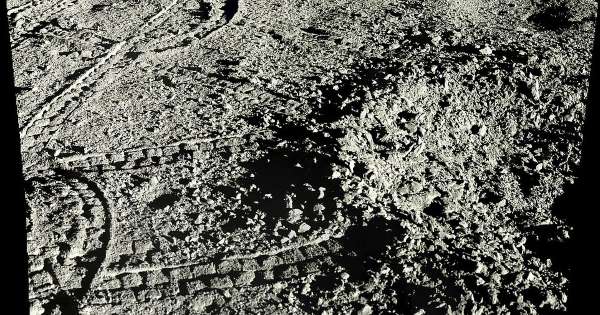China’s space agency has released a huge batch of stunning images from the far side of the moon, revealing the beauty of the mysterious terrain.
The high-resolution images were released on the agency’s dedicated website and were enhanced by a NASA expert.
Doug Ellison, who heads up the engineering camera team for the Curiosity Mars Rover at NASA, processed the images and posted them on Twitter.
One image of the Chang’e-4 lunar lander with the immaculate tracks of the Yutu-2 rover was brought to life in color using sophisticated computer software.
The images were taken by Chang’e-4 lander’s terrain camera and the panoramic camera on the Yutu-2 rover.
The data dump measured more than 10GB and includes images taken over the course of its first year in operation.
Mr. Ellison tweeted ‘Oh – this is so pretty’ after successfully debayering the photos.
Debayering is a technique that uses computer software to reveal the true color of a photo.
WHY IS THE FAR SIDE OF THE MOON KNOWN AS THE ‘DARK SIDE’?
The far side of the moon – colloquially known as the dark side – actually gets as much light as the near side but always faces away from Earth.
Less than a fifth of the opposite half of the moon is ever visible and it wasn’t until 1959 until we received images of what it looked like when the Soviet Luna 3 spacecraft returned snapped the mysterious region.
In 1968, astronauts aboard the Apollo 8 spacecraft were the first humans to set eyes on the far side in person as they orbited the moon.
Since then, several missions by NASA and other space agencies have imaged the lunar far side.
That includes NASA’s Deep Impact spacecraft, which imaged the far side from a distance of 31 million miles (49m km) in 2008.
This relatively unexplored region is mountainous and rugged, making a successful landing much harder to achieve.
Professor of astrophysics at the University of Nottingham, Christopher Conselice, said the far side is much more rugged and has less volcanic activity than the side we see from Earth.
The images were sent back in what appears to be black and white, but they are actually incomplete color images.
Computer programs can be used to extract true coloration.
Some of the images feature views of the Von Karmer crater in which the mission landed.
It is the largest impact crater in the entire solar system at eight miles (13 km) deep and 1,600 miles (2,500 km) in diameter.
The far side of the moon – colloquially known as the dark side – actually gets as much light as the near side but always faces away from Earth.
This is because the moon is tidally locked to Earth, rotating at the same rate that it orbits our planet, so the far side, or the ‘dark side’ – is never visible from our planet.
Days on the moon last for 14 Earth days thanks to its orbit around Earth and it can only operate during the lunar day when it is warmer.
Chang’e-4 and Yutu-2 are entering their 14th lunar day in operation.
The Chang’e-4 lunar probe mission – named after the moon goddess in Chinese mythology – launched last December from the southwestern Xichang launch center.
It is the second Chinese probe to land on the moon, following the Yutu rover mission in 2013.
The remarkable images are a secondary perk to the vital data that it is beaming back to Earth via its own dedicated relay satellite named Queqiao.
It is permanently stationed in operational orbit about 40,000 miles beyond the moon and is used to bounce images from the far side of the moon back to Earth.
The tasks of the Chang’e-4 include astronomical observation, surveying the moon’s terrain, landform and mineral composition, and measuring the neutron radiation and neutral atoms to study the environment on the far side of the moon.
Recently, it was revealed how an onboard biosphere was used to grow a plant on the moon.
Xie Gengxin of Chongqing University devised a cylindrical garden capsule to try and bring gardening deeper into outer space.
The capsule stood around 8 inches tall with a 6.5-inch diameter and had a rectangular seedbed that was loaded with cotton, potato, rapeseeds, a variety of weed called Arabidopsis, and fruit fly eggs.
Arabidopsis a plant used widely by scientists in experiments and is used to model how many plants will respond to various stimuli.











